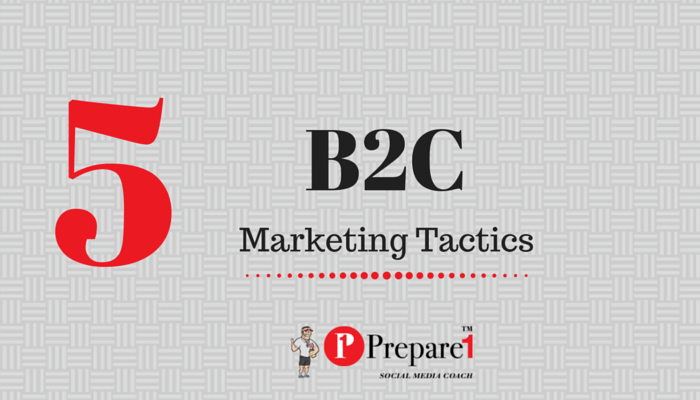
What B2C content marketing tactics do you use?
Are those tactics as effective as you would like them to be?
B2C buyers are driven by different motivations — usually, feeling safe, secure and informed — than B2B purchasers. As a result, both the intent and the messaging of your content marketing campaigns must be different.
Key takeaway: Those creating B2B content should keep the imperative of building thought leadership in mind. Those who are more active with B2C content should consider other goals, such as establishing exclusivity or cost effectiveness.
B2C TACTIC USAGE
B2C companies are virtually unlimited when it comes to potential opportunities to reach prospective customers. Besides the social networks and popular websites that typically form the backbone of a traditional content campaign, B2C customers can be reached via more traditional mediums (such as advertising), Geo-targeting apps (which allow content and promotions to be served up when a prospect nears a shop), and more.
According to a recent survey by Content Marketing Institute, B2C marketers are using more tactics, on average, than they did last year (12 vs. 11).
How many of these content marketing tactics does your organization use?
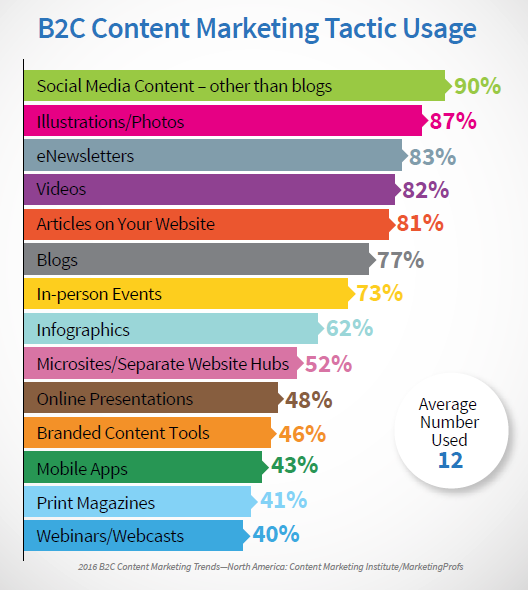
Social media content (other than blogs) remains the most often used tactic (93% last year vs. 90% this year).
The use of the following tactics increased most:
• Infographics (45% last year vs. 62% this year)
• Illustrations/photos (75% last year vs. 87% this year)
• Online presentations (36% last year vs. 48% this year)
Other than the 3% decrease in the use of social media content, along with a slight decrease for branded content tools and podcasts (-1% for both), the use of all other tactics increased.
Note: Fewer than 40% of B2C marketers said they use the following tactics:
- Case Studies (38%)
- Research Reports (36%)
- Print Newsletters (35%)
- White Papers (32%)
- Digital Magazines (31%)
- Books (31%)
- eBooks (30%)
- Virtual Conferences (26%)
- Games/Gamification (22%)
- and Podcasts (21%).
B2C EFFECTIVE TACTICS
Even though e-newsletters ranked third for most often used content marketing tactic, they ranked No. 1 when content marketers were asked which tactics were the most effective. Tied with in-person events, 67 percent of the survey participants rated e-newsletters as the most effective form of content marketing.
There was not that much of a gap when rating effectiveness of content marketing tactics, with 67 percent of the survey respondents putting e-newsletters and in-person events at the top of the list and 53 percent listing blogs, which came in last after tactics like infographics, mobile apps, videos and webinars.
E-newsletters also were the top-ranked form of content marketing when it came to subscription offers. With 69 percent of B2C content marketers claiming that their organization offered e-newsletter subscriptions, it was by far the most popular form of subscription-based content marketing. Second were blogs at 42 percent, followed by subscriptions to online communities at 18 percent.
Like last year, eNewsletters, in-person events,and illustrations/photos were rated the most effective tactics.
The top 3 content tactics B2C marketers use:
- Social media (90% of respondents)
- Illustrations/photos (87% of respondents)
- eNewsletters or eMail (83% of respondents).
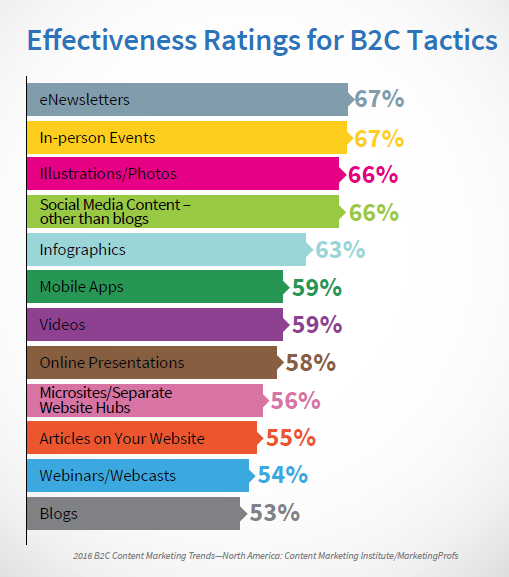
Effectiveness ratings increased for all tactics shown here, except for blogs (54% last year vs. 53% this year).
The greatest effectiveness rating increase was for infographics, up 21 percentage points (42% last year vs. 63% this year).
How effective are the tactics your organization uses?
VISUAL CONTENT MATTERS
A study by Wyzowl respondents said they remember 80% of what they see, but only 20% of what they read, and it becomes clear that visual marketing is critical to keeping you:
- Top of mind
- Relevant, and
- Memorable
But knowing how to incorporate visual marketing is still a challenge for most businesses.
- When people hear information, they’re likely to remember only 10% of that information three days later. However, if a relevant image is paired with that same information, people retained 65% of the information three days later. (Source)
- Researchers found that colored visuals increase people’s willingness to read a piece of content by 80%. (Source)
- 46% of marketers say photography is critical to their current marketing and storytelling strategies. (Source)
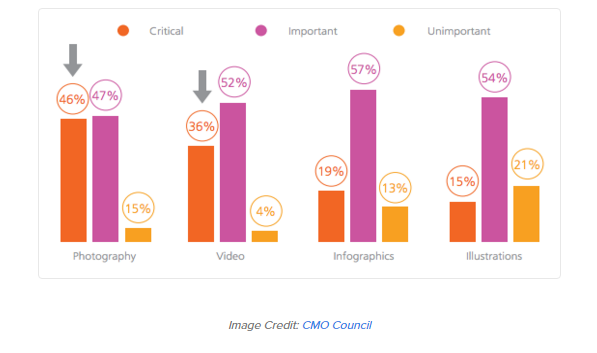
Image Credit: CMO Council
- 34% of marketers selected visual assets as their most important content, behind blogging (45%) and before videos (19%). (Source)
- 65% of senior marketing executives believe that visual assets (photos, video, illustrations and infographics) are core to how their brand story is communicated. (Source)
- Content with relevant images gets 94% more views than content without relevant images.(Source)
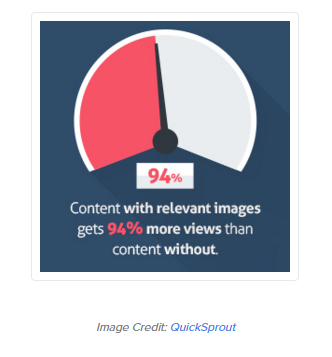
Image Credit: QuickSprout
- 73% of content creators plan to prioritize creating more engaging content in 2016, and 55% plan to prioritize creating visual content. (Source)
- 39% of marketers believe that more of their budget should be allocated to the acquisition or creation of compelling visual assets. (Source)
- Only 27% of marketers have a process in place to aggregate, organize, and manage the visual assets being used across their marketing teams. (Source)
VIDEO CONTENT STATS
Video is taking content marketing by storm, but you’ll have to do more than just make one to realize its full potential.
If it were five years in the future, would you be reading this article or would you be watching it? As online video continues its inimitable rise, it’s an interesting question to ponder.
By 2017, video will account for 69% of all consumer internet traffic, according to Cisco. Video-on-demand traffic alone will have almost trebled. Leafing through a swathe of statistics on the subject, I’m hard pressed to find any indicator that doesn’t suggest rapid growth.
With online video quickly becoming a key means for people to satisfy their information and entertainment needs, small businesses that fail to include it in their internet marketing strategies will do so at their peril.
- 51.9% of marketing professionals worldwide name video as the type of content with the best ROI. (Source)
- Shoppers who view video are 1.8 X more likely to purchase than non-viewers. (Source)
- Using the word “video” in an email subject line boosts open rates by 19%, click-through rates by 65% and reduces unsubscribes by 26%. (Source)
- Midway through 2015, mobile video plays exceeded 44% — up 74% from 2014 and up a whopping 844% since 2012. (Source)
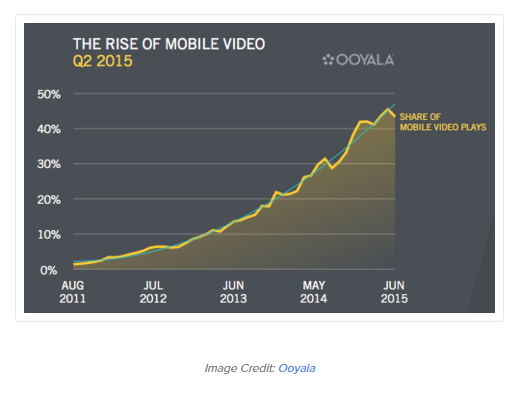
Image Credit: Ooyala
- Between April 2015 and November 2015, the amount of average daily video views on Facebook doubled from 4 billion video views per day to 8 billion. (Source)
- In July 2015, Periscope users were watching 40 years’ worth of videos every day. (Source)
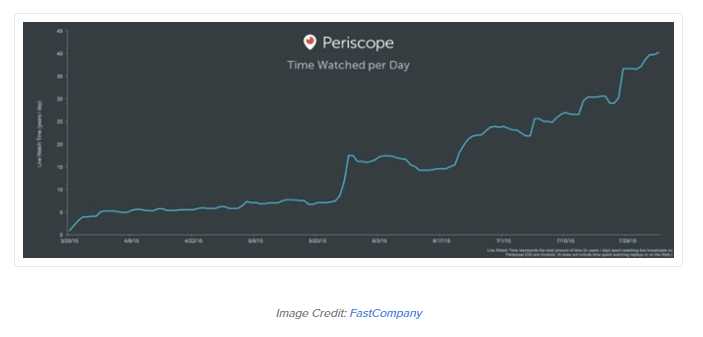
Image Credit: FastCompany
- In Q2 of 2015, mobile phones (34%) and tablets (15%) combined for 49% of video ad impressions — up from 38% in Q1 of 2015. Publishers saw PC impressions drop from 62% to 50% in the previous quarter. (Source)
- Syndacast predicts 74% of all internet traffic in 2017 will be video. (Source)
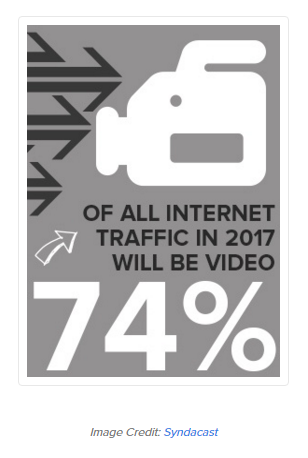
Image Credit: Syndacast
SOCIAL MEDIA CONTENT STATISTICS
- Articles with an image once every 75-100 words got double the number of social shares than articles with fewer images. (Source)
- 71% of online marketers use visual assets in their social media marketing. (Source)
- B2C marketers place more importance on visual content than B2B marketers — and a whopping 40% of B2C marketers say visual content is the most important type of content. (Source)
- Visual content is more than 40X more likely to get shared on social media than other types of content. (Source)
- Facebook posts with images see 2.3X more engagement than those without images. (Source)

Image Credit: BuzzSumo
Our focus has shifted from Social Media to VISUAL Social Media. We are drawn to “visual content” online in more ways than ever before.
The opportunity this provides for B2C business is massive. How you use these tactics to increase effectiveness is your focus. Those that get it will propel going forward, and those that don’t will be passed.
What lane do you want to be in?
JOIN US FOR OUR UPCOMING
SOCIAL MEDIA SEMINAR SERIES
- Facebook Ads – How to boost sales and leads – Jan. 28th
- YouTube & Video – How to create engaging videos that boost sales – Feb. 11th
- Visual Content for Business – How to get your business to stand out – Mar.10th
About Blair

Blair Evan Ball is a Social Media Coach and founder of Prepare1, a company that works with businesses, individuals and non-profits. He is a former executive with a Fortune 50 company, and his national division did $1Billion+ in sales annually.
Blair has written three e-books: Facebook for Business Made Easy, Facebook Pages for Business Made Easy, and WordPress Blog Setup Made Easy.
Blair also educates, trains entrepreneurs and business professionals how to amplify their brand, increase revenues, and raise more funds.
![[Study] How Will Businesses Change Their Social Media Activities 5 Golden Rules for Sharing on Social Media](https://www.prepare1.com/wp-content/uploads/2014/03/COACH-logohat-162x300.jpg) The Race is ON! | PREPARE | Get into the Game and WIN!
The Race is ON! | PREPARE | Get into the Game and WIN!

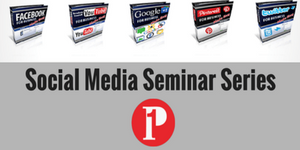



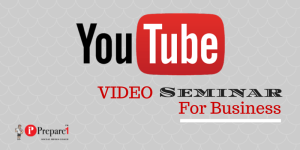





Comments on this entry are closed.